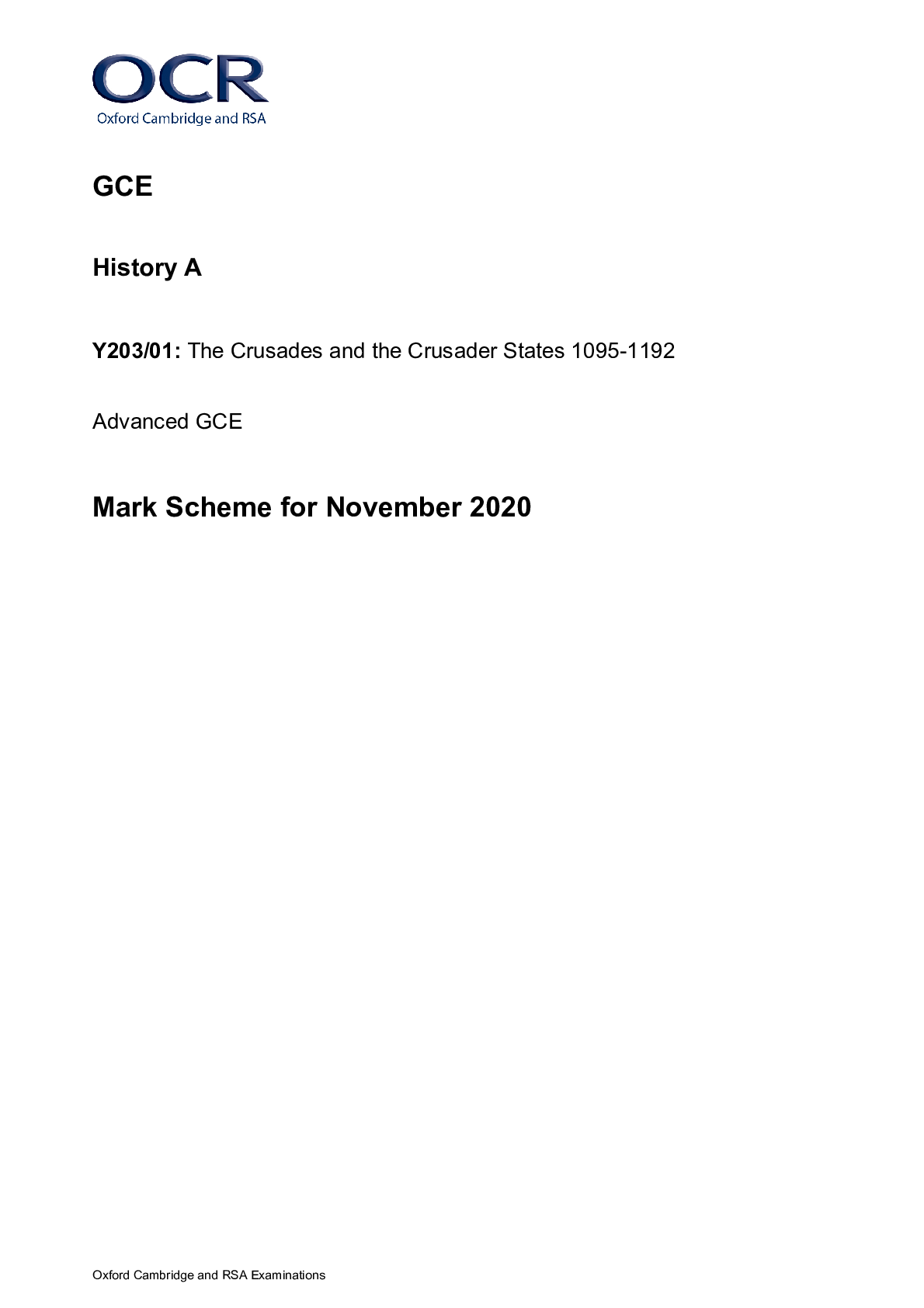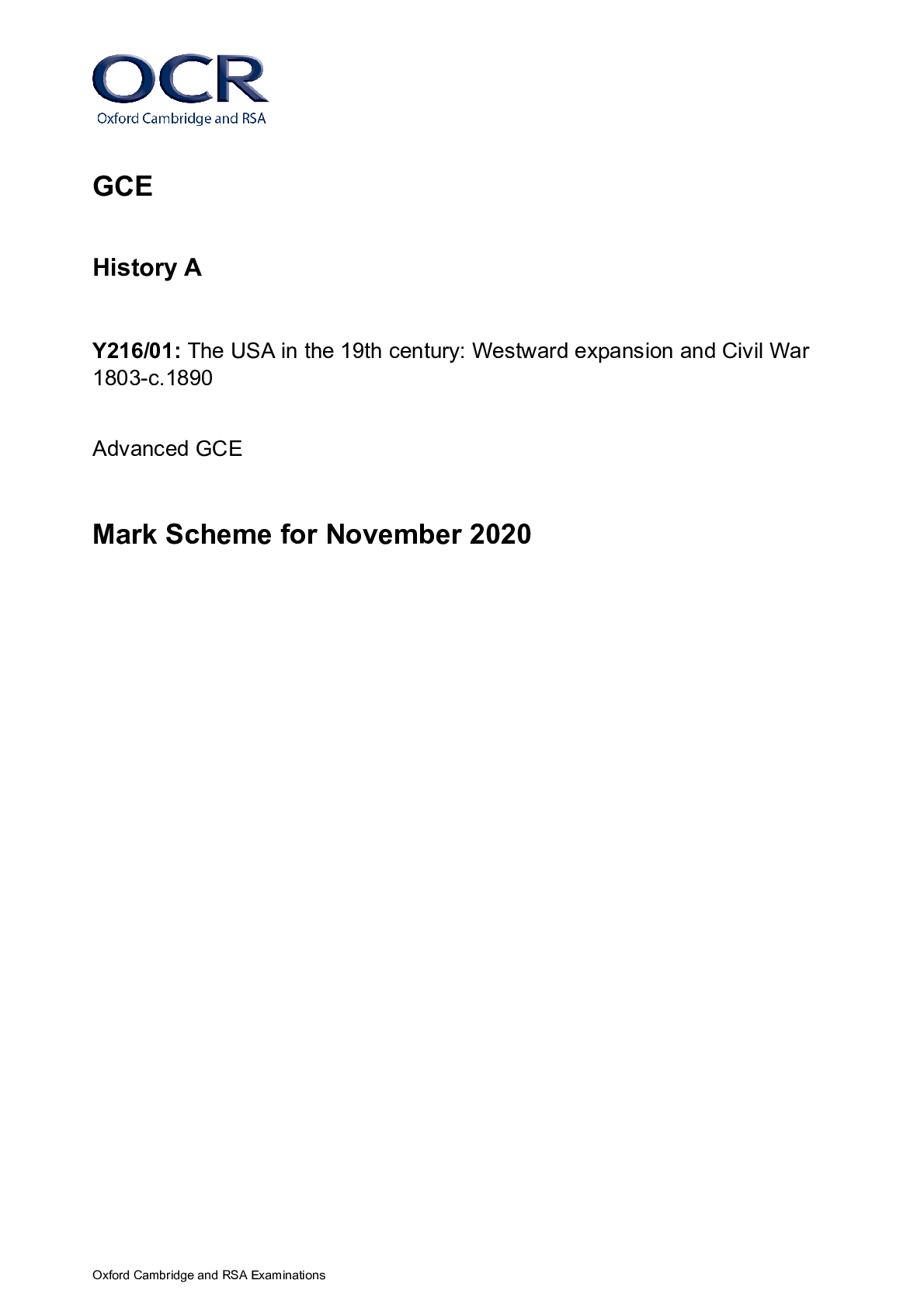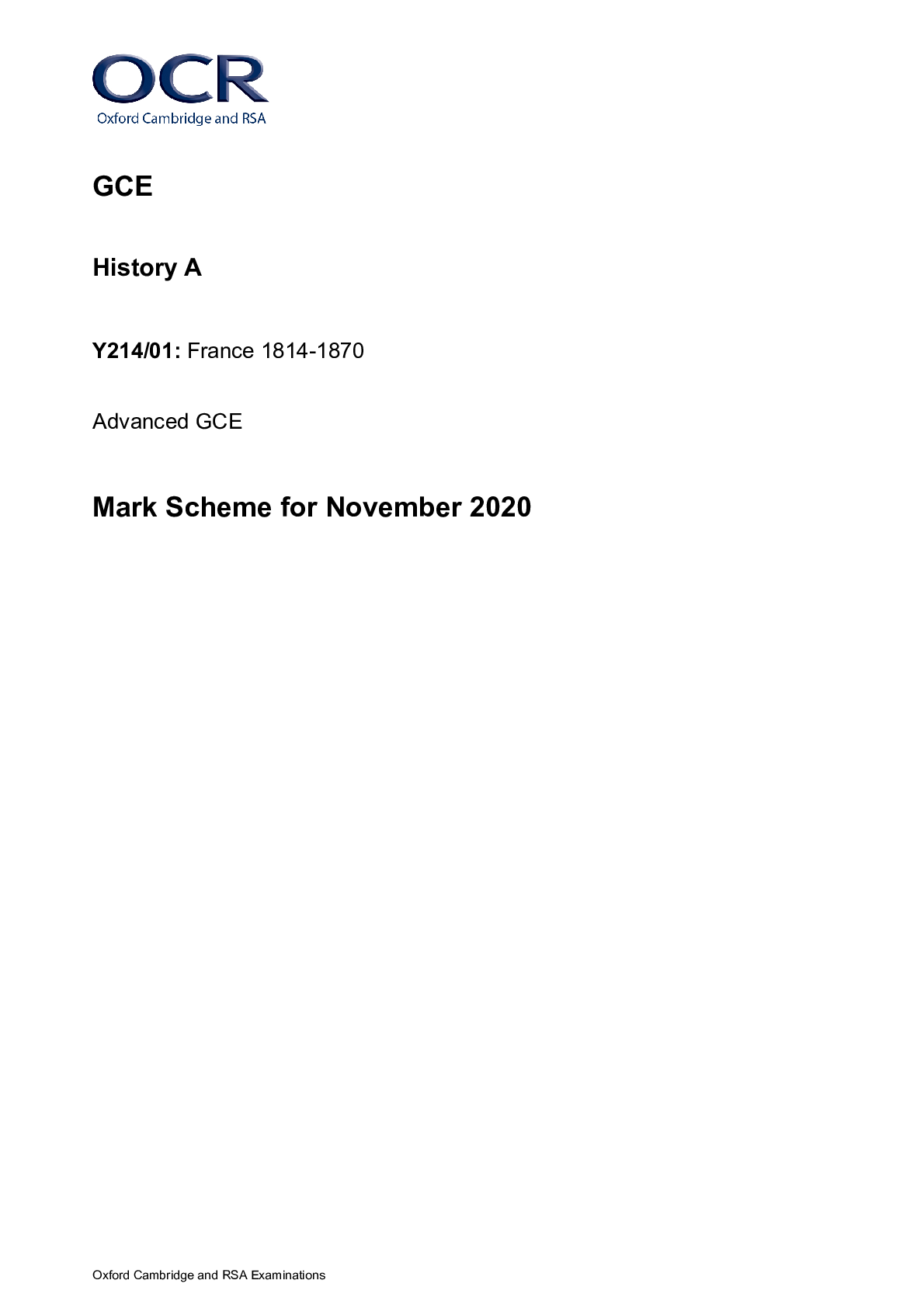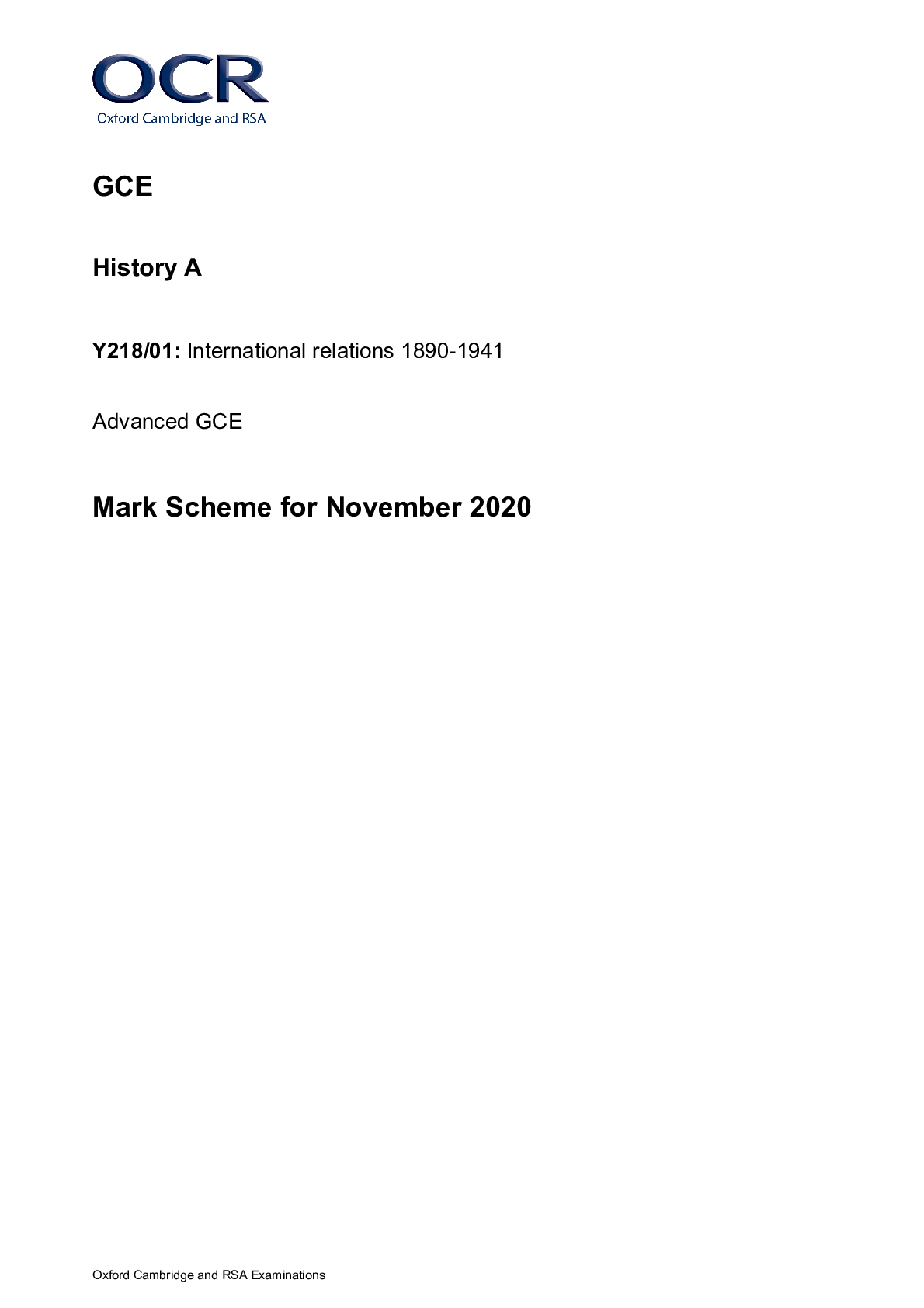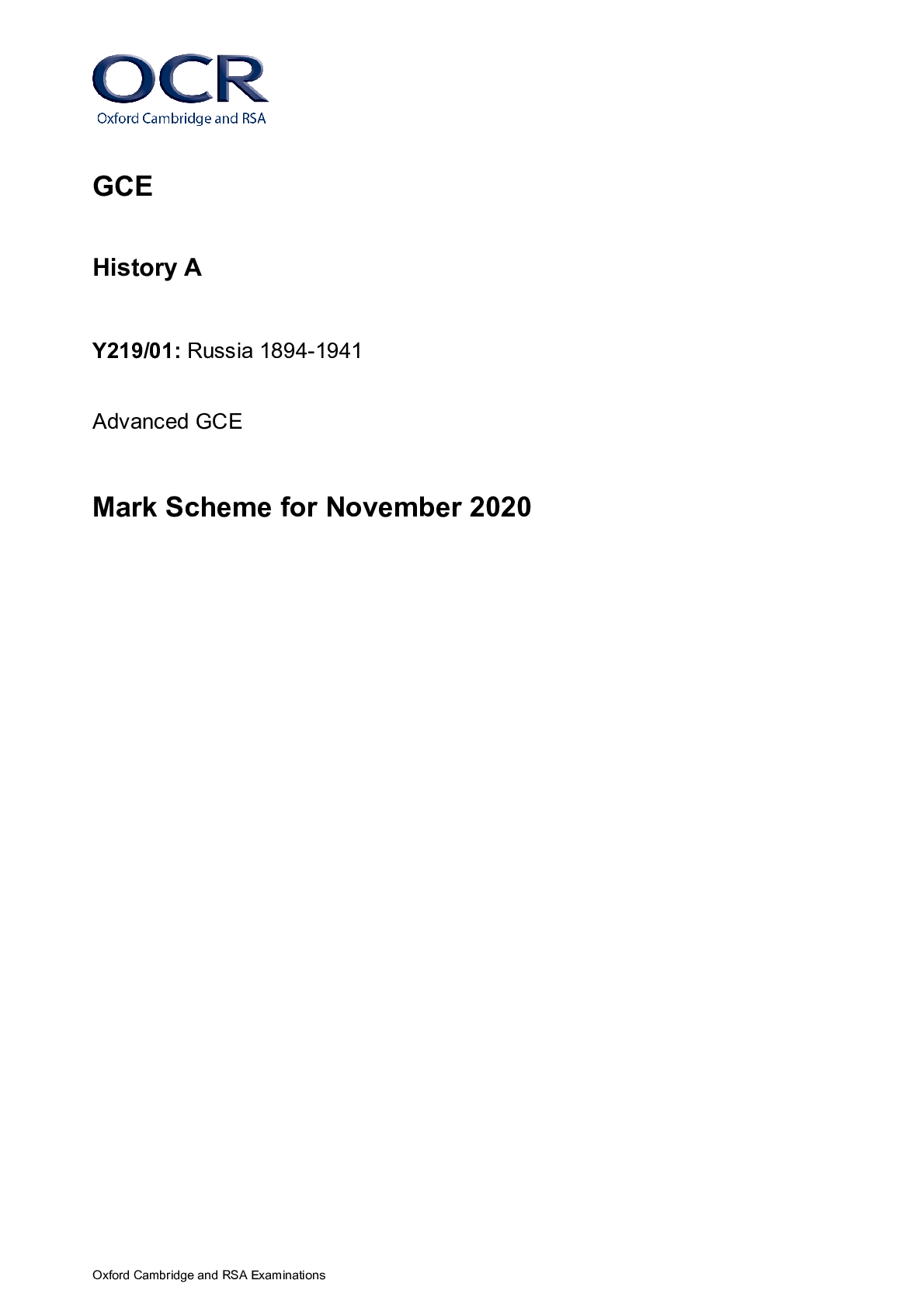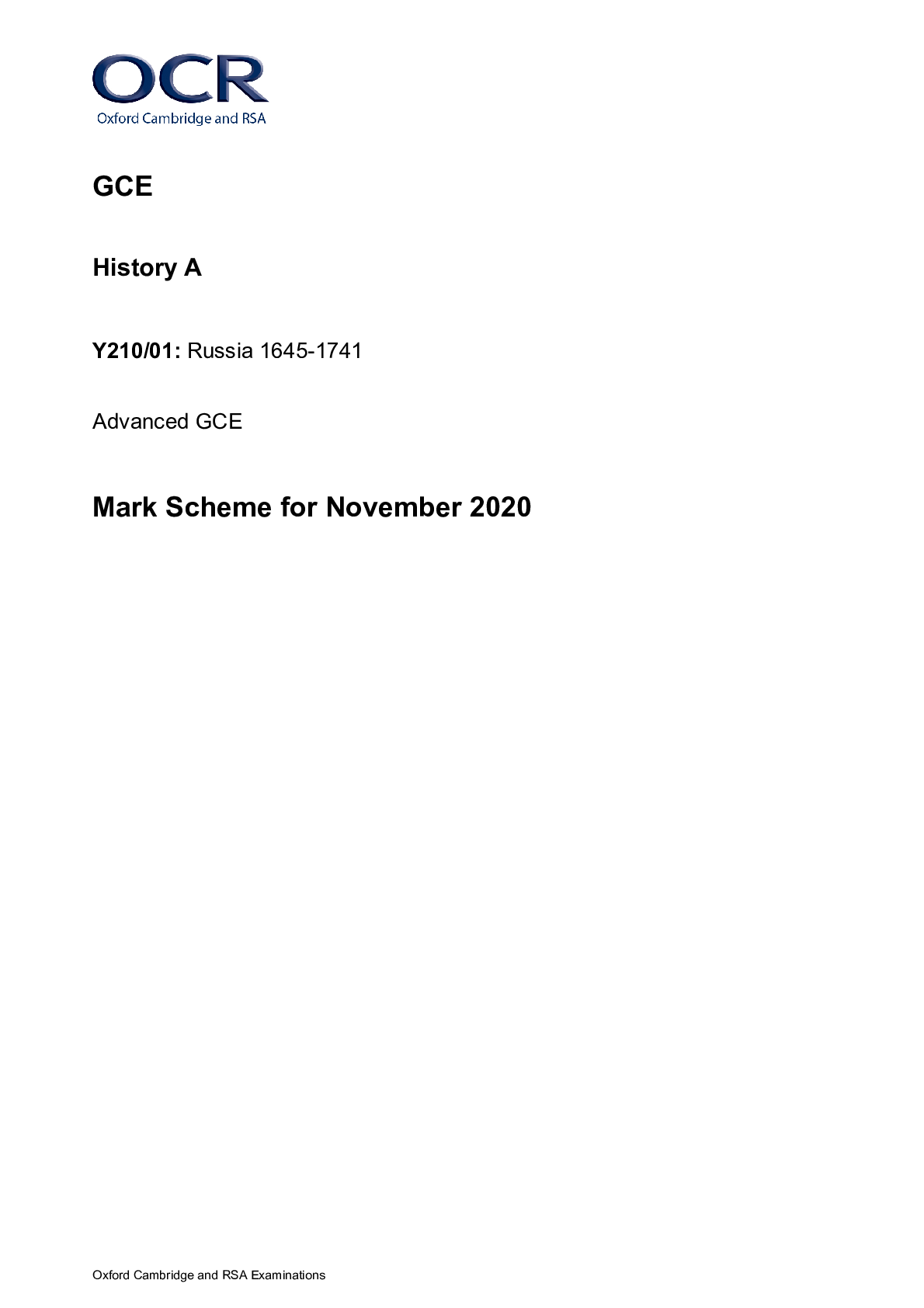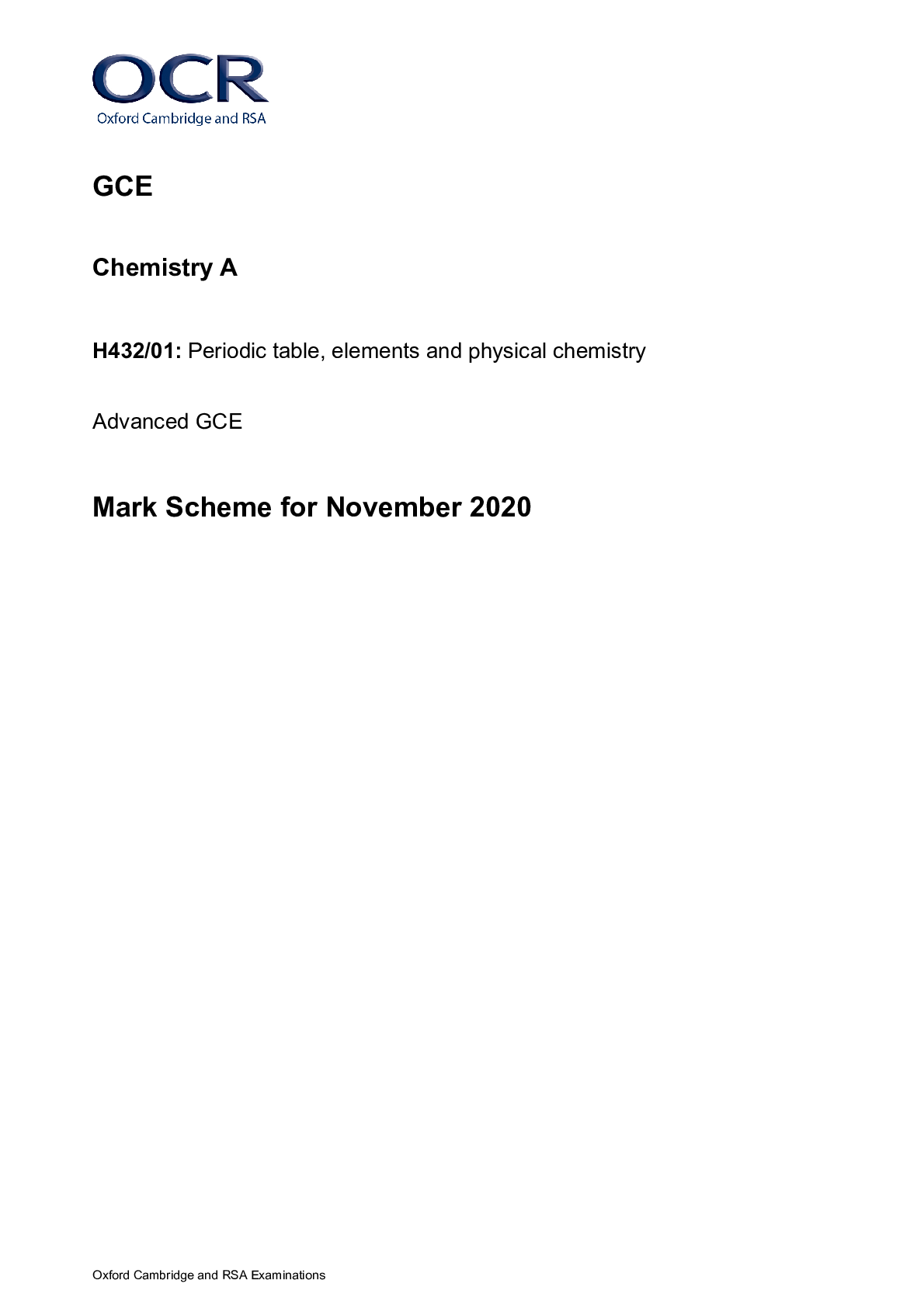Economics > AS Mark Scheme > GCE Economics H060/01: Microeconomics Advanced Subsidiary GCE Mark Scheme for November 2020 (All)
GCE Economics H060/01: Microeconomics Advanced Subsidiary GCE Mark Scheme for November 2020
Document Content and Description Below
GCE Economics H060/01: Microeconomics Advanced Subsidiary GCE Mark Scheme for November 2020 Oxford Cambridge and RSA Examinations GCE Economics H060/01: Microeconomics Advanced Subsidiary... GCE Mark Scheme for November 2020Oxford Cambridge and RSA Examinations OCR (Oxford Cambridge and RSA) is a leading UK awarding body, providing a wide range of qualifications to meet the needs of candidates of all ages and abilities. OCR qualifications include AS/A Levels, Diplomas, GCSEs, Cambridge Nationals, Cambridge Technicals, Functional Skills, Key Skills, Entry Level qualifications, NVQs and vocational qualifications in areas such as IT, business, languages, teaching/training, administration and secretarial skills. It is also responsible for developing new specifications to meet national requirements and the needs of students and teachers. OCR is a not-for-profit organisation; any surplus made is invested back into the establishment to help towards the development of qualifications and support, which keep pace with the changing needs of today’s society. This mark scheme is published as an aid to teachers and students, to indicate the requirements of the examination. It shows the basis on which marks were awarded by examiners. It does not indicate the details of the discussions which took place at an examiners’ meeting before marking commenced. All examiners are instructed that alternative correct answers and unexpected approaches in candidates’ scripts must be given marks that fairly reflect the relevant knowledge and skills demonstrated. Mark schemes should be read in conjunction with the published question papers and the report on the examination. © OCR 2020H060/01 Mark Scheme November 2020 Annotations Annotation Meaning Blank Page – this annotation must be used on all blank pages within an answer booklet (structured or unstructured) and on each page of an additional object where there is no candidate response. Tick Cross Comment Benefit of doubt Level 1 Level 2 Level 3 Level 4 Omission Not answered question Noted but no credit given Too vague Own figure ruleH060/01 Mark Scheme November 2020 12. Subject–specific Marking Instructions INTRODUCTION Your first task as an Examiner is to become thoroughly familiar with the material on which the examination depends. This material includes: • the specification, especially the assessment objectives • the question paper and its rubrics • the mark scheme. You should ensure that you have copies of these materials. You should ensure also that you are familiar with the administrative procedures related to the marking process. These are set out in the OCR booklet Instructions for Examiners. If you are examining for the first time, please read carefully Appendix 5 Introduction to Script Marking: Notes for New Examiners. Please ask for help or guidance whenever you need it. Your first point of contact is your Team Leader. Rubric Infringement Candidates may infringe the rubric in the following way: • answering two questions from Section C. If a candidate has written two answers for Section C, mark both answers and award the highest mark achieved. USING THE MARK SCHEME Please study this Mark Scheme carefully. The Mark Scheme is an integral part of the process that begins with the setting of the question paper and ends with the awarding of grades. Question papers and Mark Schemes are developed in association with each other so that issues of differentiation and positive achievement can be addressed from the very start. This Mark Scheme is a working document; it is not exhaustive; it does not provide ‘correct’ answers. The Mark Scheme can only provide ‘best guesses’ about how the question will work out, and it is subject to revision after we have looked at a wide range of scripts. The Examiners’ Standardisation Meeting will ensure that the Mark Scheme covers the range of candidates’ responses to the questions, and that all Examiners understand and apply the Mark Scheme in the same way. The Mark Scheme will be discussed and amended at the meeting, and administrative procedures will be confirmed. Co–ordination scripts will be issued at the meeting to exemplify aspects of candidates’ responses and achievements; the co–ordination scripts then become part of this Mark Scheme. Before the Standardisation Meeting, you should read and mark in pencil a number of scripts, in order to gain an impression of the range of responses and achievement that may be expected. In your marking, you will encounter valid responses which are not covered by the Mark Scheme: these responses must be credited. You will encounter answers which fall outside the ‘target range’ of Bands for the paper which you are marking. Please mark these answers according to the marking criteria. Please read carefully all the scripts in your allocation and make every effort to look positively for achievement throughout the ability range. Always be prepared to use the full range of marks.H060/01 Mark Scheme November 2020 INSTRUCTIONS TO EXAMINERS: A INDIVIDUAL ANSWERS 1 The indicative content indicates the expected parameters for candidates’ answers, but be prepared to recognise and credit unexpected approaches where they show relevance. 2 Using ‘best–fit’, decide first which set of BAND DESCRIPTORS best describes the overall quality of the answer. Once the band is located, adjust the mark concentrating on features of the answer which make it stronger or weaker following the guidelines for refinement. • Highest mark: If clear evidence of all the qualities in the band descriptors is shown, the HIGHEST Mark should be awarded. • Lowest mark: If the answer shows the candidate to be borderline (i.e. they have achieved all the qualities of the bands below and show limited evidence of meeting the criteria of the band in question) the LOWEST mark should be awarded. • Middle mark: This mark should be used for candidates who are secure in the band. They are not ‘borderline’ but they have only achieved some of the qualities in the band descriptors. 3 Be prepared to use the full range of marks. Do not reserve (e.g.) high Band 6 marks ‘in case’ something turns up of a quality you have not yet seen. If an answer gives clear evidence of the qualities described in the band descriptors, reward appropriately. B TOTAL MARKS 1 Transfer the mark awarded to the front of the script. 2 The maximum mark for the paper is 60. 3 The quality of the extended response is assessed on this parts of the question paper which are identified with the use of an asterisk (*). The assessment of this skill is embedded within each of the levels of response and it must be considered when determining the mark to be awarded within the appropriate level.H060/01 Mark Scheme November 2020 Levels of response / Level descriptors Knowledge and understanding/ Application Analysis Evaluation Strong Precision in the use of the terms in the question and applied in a focused way to the context of the question. An explanation of causes and consequences, fully developing the links in the chain of argument. A conclusion is drawn weighing up both sides, and reaches a supported judgement. Good An explanation of causes and consequences, developing most of the links in the chain of argument. A conclusion is drawn weighing up both sides, but without reaching a supported judgement. Reasonable Awareness of the meaning of the terms in the question and applied to the context of the question. An explanation of causes and consequences, which omit some key links in the chain of argument. Some attempt to come to a conclusion, which shows some recognition of the influencing factors. Limited Awareness of the meaning of the terms in the question. Simple statement(s) of cause and consequence. An unsupported assertion.H060/01 Mark Scheme November 2020 Multiple Choice Questions Answer 1. B 2 D 3 A 4 C 5 C 6 B 7 C 8 B 9 A 10 B 11 D 12 A 13 D 14 C 15 AH060/01 Mark Scheme November 2020 Question Key Rationale AO Quantitative Skills 1 B Rationale A. This is a characteristic of a market economy B. Correct: This is a characteristic of a planned economy C. This is a characteristic of a market economy D. This is a characteristic of a market economy 1 2 D Rationale A. This is not the result of division of labour B. Firms are likely to spend less on training C. This is a cost of division of labour to the consumer D. Correct: Division of labour leads to higher productivity and output per unit of labour input falls 1 3 A Rationale A. Correct: This can be tested with objective evidence B. This is a subjective opinion C. This is a subjective opinion D. This is a subjective opinion 1 4 C Rationale A This is the change in quantity supplied as the market moved to equilibrium. B This is the change in quantity supplied if the market originally and a shortage of 36. C Correct. Demand would originally have been 46. It then increased to 64. D This is the change in quantity demanded if the market had moved to equilibrium from a shortage of 36. 2 xH060/01 Mark Scheme November 2020 5 C Rational A Quantity supplied would now be 10 and there would be a shortage of 20. B Quantity supplied would now be 15 and there would be a shortage of 10. C Correct. Quantity demanded and quantity supplied would now be in equilibrium. Firms would supply at a price of £8 what they had previously supplied at £6 (£8 – tax). D Quantity supplied would now be 25 and there would be a surplus of 10. 3 x 6 B Rationale A PES is 2.0 rather than the price change being £2. B Correct. 2.0 = 30%/? = 15%. Price rose by 15% i.e. £9. C The change in price is £15 rather than 15%. D £18 is 30% of 60. 30% is the change in quantity supplied. 2 x 7 C Rationale A Quantity traded is at its highest but total revenue is only £2,100. B Total revenue is £2,400. C Correct. Total revenue is £2,500. D Total revenue is £2,400. 2 xH060/01 Mark Scheme November 2020 8 B Rationale A This is a cost to the firm B. Correct: This is an external benefit to a third party (i.e. fruit growers) C. This is a private benefit to the hotel D. This is a benefit to workers 1 9 A Rationale A. Correct: The price mechanism allocates resources B. Government failure is an effect of government intervention in a market C. Effective demand is ability and willingness to pay D. The price mechanism may increase competition 1 10 B Rationale A Benefits to third parties are unlikely to arise from the discharge of waste into a river B Correct: the reduction in the discharge of waste reduces the cost on third parties C The benefit to the firm in the form of revenue is unlikely to change, although if it creates a better image for the firm, it may increase sales and raise revenue D The cost to the firm, in the short run, is likely to increase as money will be spent on the new technology 2H060/01 Mark Scheme November 2020 11 D Rationale A This is a movement along the PPC when all resources are being used. It is not a movement from an initial position when not all resources are being used B This represents a fall and not an increase in the output of consumer goods C This does show an increase in the use of resources but a fall in the output of consumer goods D Correct: This is a movement from inside the PPC which raises the output of consumer goods 2 x 12 A Rationale A Correct: More information would alert consumers to the negative externalities, causing demand to fall. Putting more information on the production would raise the costs of production B The supply curve would not shift to the right and the quantity traded would decrease C The demand curve would not shift to the right and the quantity traded would decrease D Neither the demand curve nor the supply curve would shift to the right and the quantity traded would decrease 3 x 13 D Rationale A. This concerns the cross elasticity of demand between two goods B. Price and quantity demanded are usually inversely related C. Cross elasticity of demand is the relationship between a change in the price of one product and demand for another product D. Correct This means that as income rises demand falls as in the case of an inferior good 3 xH060/01 Mark Scheme November 2020 14 C Rationale A. Healthcare is ‘free at point of use’ but imposes an opportunity cost as it uses scarce resources B. Street lighting is a public good C. Correct: Sunlight is not scarce, and its use does not impose an opportunity cost D. This is a price reduction in a market 1 15 A Rationale A. Correct: This is part of the payment to labour for factor services B. This is a payment for the exchange of goods and services C. This way of creating brand loyalty D. This is not for labour services. Pensions are paid by the government or firms to workers who are retired 2H060/01 Mark Scheme November 2020 Question Answer Marks Guidance 16 a i Calculate the amount spent on going to gigs and festivals in July 2014 £9b/1.085 = £8.295b 2 (AO1x1) (AO2x1) 2 marks for correct answer including £bn Award 1 mark if correct method or correct answer with no £bn Quantitative skills rewarded in this question 16 a ii Which festival ticket saw the biggest proportionate increase in price between 2006 and 2015? Latitude [102.6%] 1 (AO1x1) This is the only acceptable answer 16 b i Using information in the case study (but excluding price) explain one reason why there has been an increase in demand for tickets at the Green Man festival Better weather (tastes\seasonal factors) this means that more consumers are willing to go to festivals. Improved transport (availability of complements) this makes it easier for consumers to get to festivals 2 (AO1x1) (AO2x1) Do not accepts factors that affect demand that are not in the case study. One mark for identifying the factor AND one mark for linking it to a factor OR how it will lead to an increase in demand. 16 b ii Using Figure 2 describe what happened to the time taken to sell Glastonbury tickets between 2010 and 2014. The time taken to sell tickets has fallen from 12 hours to 1 hour and 27 minutes 2 (AO1x2) 1 mark for ‘fall’ 1 mark for times from the data Award 2 marks for - reduction of 10hours 33 minutes.H060/01 Mark Scheme November 2020 16 c The number of tickets to Glastonbury Festival is fixed at 190,000. Using an appropriate diagram, explain why there is disequilibrium in the market for Glastonbury Festival tickets. Up to 2 marks for diagram Demand curve with label (1) Perfectly Inelastic supply curve with label (1) Excess demand shown on diagram e.g. on axes; using demand curve (1) Up to 2 marks for explanation Demand exceeds supply (1) Supply of tickets is fixed (1) Reference to case study (Figure 2) (1) 4 (AO1x2) (AO2x2) Axis must be labelled for diagram to be rewarded. Quantitative skills rewarded in this question 16 d Explain how the additional policing costs would affect the price of Glastonbury festival tickets Policing costs are paid by the festival organisers (1) This will lead to an increase in costs of production. (1) This will lead to a fall in supply (1) and the price of tickets will rise (1) 4 (AO1x2) (AO2x2) If no written explanation allow up to 2 marks for the supply decreases and price rise shown on a diagram. Award 1 mark for correct use of figures from the case study: • Policing costs are £287 000, or tickets will rise above £220.H060/01 Mark Scheme November 2020 Question Answer Marks Guidance 16 e Evaluate the usefulness of price elasticity of demand for tickets to the organisers of the Green Man festival. Level 3 (7-10 marks) Good – strong analysis of price elasticity of demand (PED). Good analysis will be in the form of developed links. These links are developed through a chain of reasoning which addresses the question. Any relevant diagram(s) are predominantly correct and linked to the analysis. Strong analysis will have consistently welldeveloped links through a coherent chain of reasoning which addresses the question. Any relevant diagram(s) are predominantly correct with no significant errors that affect the validity of the analysis. Any diagrams must be integral to the analysis. Good - strong evaluation of the limitations of PED estimates, weighing up both sides/comparing alternatives. Strong evaluation should include a supported judgement. There is a well-developed line of reasoning which is clear and logically structured. The information presented is relevant and substantiated. Level 2 (4-6 marks) Reasonable analysis of price elasticity of demand (PED). There is correct analysis largely in the form of single links. These address the question but are not developed into a clear chain of reasoning. Any relevant diagram(s) may be imperfectly labelled or not linked to the analysis. 10 (AO2x1 AO3x4 AO4x5) Examples of analysis may include: PED is 23/ (50/300) = (-)1.385 which is elastic. When PED is elastic quantity demanded rises more than proportionally when there is a fall in price. When price is decreased, total revenue will increase, therefore the organisers should have reduced price. PED is useful as the organisers need to be able to predict the impact of price changes on ticket sales. This will help them to know how much to reduce price by to sell as many tickets as possible. Examples of evaluation could include: TR may change but effect on profit is unknown as no information on costs. PED calculations are estimates which may be inaccurate/unreliable. PED is based on historical data which may not hold true over time. PED varies along the demand curve therefore reducing price further may cause PED to become unitary or inelastic. Other factors affect demand e.g. weather meaning final change in revenue/demand/ticket sales uncertain.H060/01 Mark Scheme November 2020 Reasonable evaluation of the limitations of PED estimates considering both sides/comparing alternatives. There is a line of reasoning presented with some structure. The information presented is in the most part relevant and supported by some evidence. Level 1 (1-3 marks) Limited analysis based on application of knowledge and understanding of price elasticity of demand (PED). There is little evidence of reasoning that addresses the question asked. There is a lack of a clear structure. Any relevant diagram(s) may not be present or are incorrectly labelled. Limited evaluation of the limitations of PED estimates in the form of an unsupported statement or no evaluation. Information is basic and communicated in an unstructured way. The information is supported by limited evidence. The relationship to the evidence may not be clear. 0 marks no response worthy of credit Descriptor Award mark Consistently meets the criteria for this level At top of level Meets the criteria but with some slight inconsistency Above middle and either below top of level or at middle of level (depending on number of marks available) Just enough achievement on balance for this level Above bottom and either below middle or at middle of level (depending on number of marks available) On the borderline of this level and the one below At bottom of levelH060/01 Mark Scheme November 2020 Question Answer Marks Guidance 17 Evaluate, using an appropriate diagram(s), the effectiveness of reducing the tax on gym membership to encourage people to take more exercise Level 4 (16-20 marks) Good knowledge and understanding of the effect of a fall in tax on gym membership Strong analysis will have consistently well-developed links through a coherent chain of reasoning which addresses the question. Any relevant diagram(s) are predominantly correct with no significant errors that affect the validity of the analysis. Any diagrams must be integral to the analysis. Strong evaluation of the effect of a fall in tax on gym membership weighing up both sides/comparing alternatives and reaching a supported judgement. There is a well-developed line of reasoning which is clear and logically structured. The information presented is relevant and substantiated. Level 3 (11-15 marks) Good knowledge and understanding of a fall in tax on gym membership. Good analysis of the effect of a fall in tax on gym membership. There is correct analysis in the form of developed links. These links are developed through a chain of reasoning which addresses the question. Any relevant 20 (AO1x3) (AO2x4) (AO3x6) (AO4x7) The effect of a fall in an indirect tax will be to reduce the cost of production for gyms. This will increase supply shifting supply from S 1 to S2. This will lead to a fall in price (P1 to P2) an extension in demand and an increase in quantity consumed (Q1 to Q2). This means that more consumers have been incentivised to take up gym membership because the price has fallen. Candidates may consider: Gym membership could be considered as a good that creates positive externalities. If not enough consumers take out gym membership then the good will be under consumed and underprovided. This means that there is a market failure. The increase in consumption will mean that gym membership will be closer to the social optimum (i.e. MSC = MSB). This is because the increase in gym membership will create positive externalities e.g. less public spending on health (as fitness increases) and greater productivity. This is a benefit toH060/01 Mark Scheme November 2020 diagram(s) are predominantly correct and linked to the analysis. Good evaluation will weigh up both sides/comparing alternatives but without reaching a supported judgement. There is a line of reasoning presented with some structure. The information presented is in the most part relevant and supported by some evidence. Level 2 (6-10 marks) Reasonable knowledge and understanding of the effect of a fall in tax on gym membership Reasonable analysis of the effect the economic impact of a fall in tax on gym membership. There is correct analysis largely in the form of single links. These address the question but are not developed into a clear chain of reasoning. The relevant diagram(s), if present, may be imperfectly labelled or not linked to the analysis. Reasonable evaluation of the economic impact of a fall in tax on gym membership considering both sides/comparing alternatives. The information has some relevance and is presented with limited structure. The information is supported by limited evidence. Level 1 (1-5 marks) Limited knowledge and understanding of the effect of a fall in tax on gym membership taxpayers and employers. This means that the market for gym membership will be more allocatively efficient and will help address the market failure associated with underconsumption of gym membership. Evaluation should consider how effective a tax reduction might be. Effectiveness will depend on the size of the reduction in tax. If the reduction is small, then the price of gym membership will not fall sufficiently to encourage people to go to a gym. Thus, the reduction needs to be significant to have any real effect. PED for gym membership will be important. If it is inelastic then even a significant reduction will lead to only a relatively smaller uptake in membership. This means that PED needs to be elastic for a tax reduction to be highly effective. All of this assumes ceteris paribus. If real incomes fall or the price of substitutes for gyms falls then a reduction in tax and therefore of price might not have much effect on gym membership. A rise in other costs may mean that despite the fall in tax overall costs rise and the price does not fall. In any case, even if people take out membership there is no guarantee that they will exercise more.H060/01 Mark Scheme November 2020 Limited or no analysis the economic impact of a fall in tax on gym membership. There is little evidence of reasoning that addresses the question asked. There is a lack of a clear structure. The relevant diagram(s) may not be present or incorrectly labelled. Limited evaluation of the economic impact of a fall in tax on gym membership in the form of an unsupported statement or no evaluation. Information is basic and communicated in an unstructured way. The information is supported by limited evidence. The relationship to the evidence may not be clear. 0 marks no response worthy of credit Descriptor Award mark Consistently meets the criteria for this level At top of level Meets the criteria but with some slight inconsistency Above middle and either below top of level or at middle of level (depending on number of marks available) Meets most of the criteria with some inconsistencies Middle of level Just enough achievement on balance for this level Above bottom and either below middle or at middle of level (depending on number of marks available) On the borderline of this level and the one below At bottom of levelH060/01 Mark Scheme November 2020 Question Answer Marks Guidance 18 Evaluate, using an appropriate diagram(s), the effect of an increase in energy prices on the producer surplus of energy supply firms. Level 4 (16-20 marks) Good knowledge and understanding of the effect of a rise in price on producer surplus. Strong analysis will have consistently well-developed links through a coherent chain of reasoning which addresses the question. Any relevant diagram(s) are predominantly correct with no significant errors that affect the validity of the analysis. Any diagrams must be integral to the analysis. Strong evaluation of the effect of a rise in price on producer surplus, weighing up both sides/comparing alternatives and reaching a supported judgement. There is a well-developed line of reasoning which is clear and logically structured. The information presented is relevant and substantiated. Level 3 (11-15 marks) Good knowledge and understanding of the effect of a rise in price on producer surplus. Good analysis of the effect of a rise in price on producer surplus. 20 (AO1x3) (AO2x4) (AO3x6) (AO4x7) Producer surplus is the difference between the price that a producer is willing and able to supply at and the market price. A rise in price (from P1 to P2) will lead to an increase in quantity supplied (from Q1 to Q2) At P1 producer surplus is (O,P1,x1) . At P2 producer surplus is O,P2,x2. There has been an increase in producer surplus of P1,P2,x2,x1. The effect of this increase will depend on the size of the price increase. If the price increase is large then this will have a bigger effect on quantity supplied leading to a bigger increase on the size of producer surplus. Whether 6% is large is unknown. The change in the size of producer surplus depends on PES. If PES is inelastic then the increase in the producer surplus will be smaller than if the PES was elastic. The above assumes a condition of ceteris paribus. If, for instance, the cost of producing energy rises then this might wholly or partially offset any gain in producer surplus from a price increase.H060/01 Mark Scheme November 2020 There is correct analysis in the form of developed links. These links are developed through a chain of reasoning which addresses the question. Any relevant diagram(s) are predominantly correct and linked to the analysis. Good evaluation will weigh up both sides/comparing alternatives but without reaching a supported judgement. There is a line of reasoning presented with some structure. The information presented is in the most part relevant and supported by some evidence. Level 2 (6-10 marks) Reasonable knowledge and understanding of the effect of a rise in price on producer surplus. Reasonable analysis of the effect on the effect of a rise in price on producer surplus. There is correct analysis largely in the form of single links. These address the question but are not developed into a clear chain of reasoning. The relevant diagram(s), if present, may be imperfectly labelled or not linked to the analysis. Reasonable evaluation of the effect of a rise in price on producer surplus on a market considering both sides/comparing alternatives. The information has some relevance and is presented with limited structure. The information is supported by limited evidence.H060/01 Mark Scheme November 2020 Level 1 (1-5 marks) Limited knowledge and understanding of the effect of a rise in price on producer surplus. Limited or no analysis of the effect of a rise in price on producer surplus. There is little evidence of reasoning that addresses the question asked. There is a lack of a clear structure. The relevant diagram(s) may not be present or incorrectly labelled. Limited evaluation of the effect of a rise in price on producer surplus. in the form of an unsupported statement or no evaluation. Information is basic and communicated in an unstructured way. The information is supported by limited evidence. The relationship to the evidence may not be clear. 0 marks no response worthy of credit Descriptor Award mark Consistently meets the criteria for this level At top of level Meets the criteria but with some slight inconsistency Above middle and either below top of level or at middle of level (depending on number of marks available) Meets most of the criteria with some inconsistencies Middle of level Just enough achievement on balance for this level Above bottom and either below middle or at middle of level (depending on number of marks available) On the borderline of this level and the one below At bottom of levelH060/01 Mark Scheme November 2020 Question AO1 AO2 AO3 AO4 Total 1 to 15 6 6(6) 3(2) 15 (8) 16(a)i 1 1(1) 2 (a)ii 1 1 (b) i 1 1 2 (b) ii 2 2 (c) 2 2 (2) 3(2) (d) 2 2(2) 4 (2) (e) 2 3 (2) 5 (2) 8 (4) 17 or 18 3 4 (2) 6 (3) 7 (3) 20 (8) Total 18 18 12 12 60 (24)OCR (Oxford Cambridge and RSA Examinations) The Triangle Building Shaftesbury Road Cambridge CB2 8EA [Show More]
Last updated: 1 year ago
Preview 1 out of 24 pages
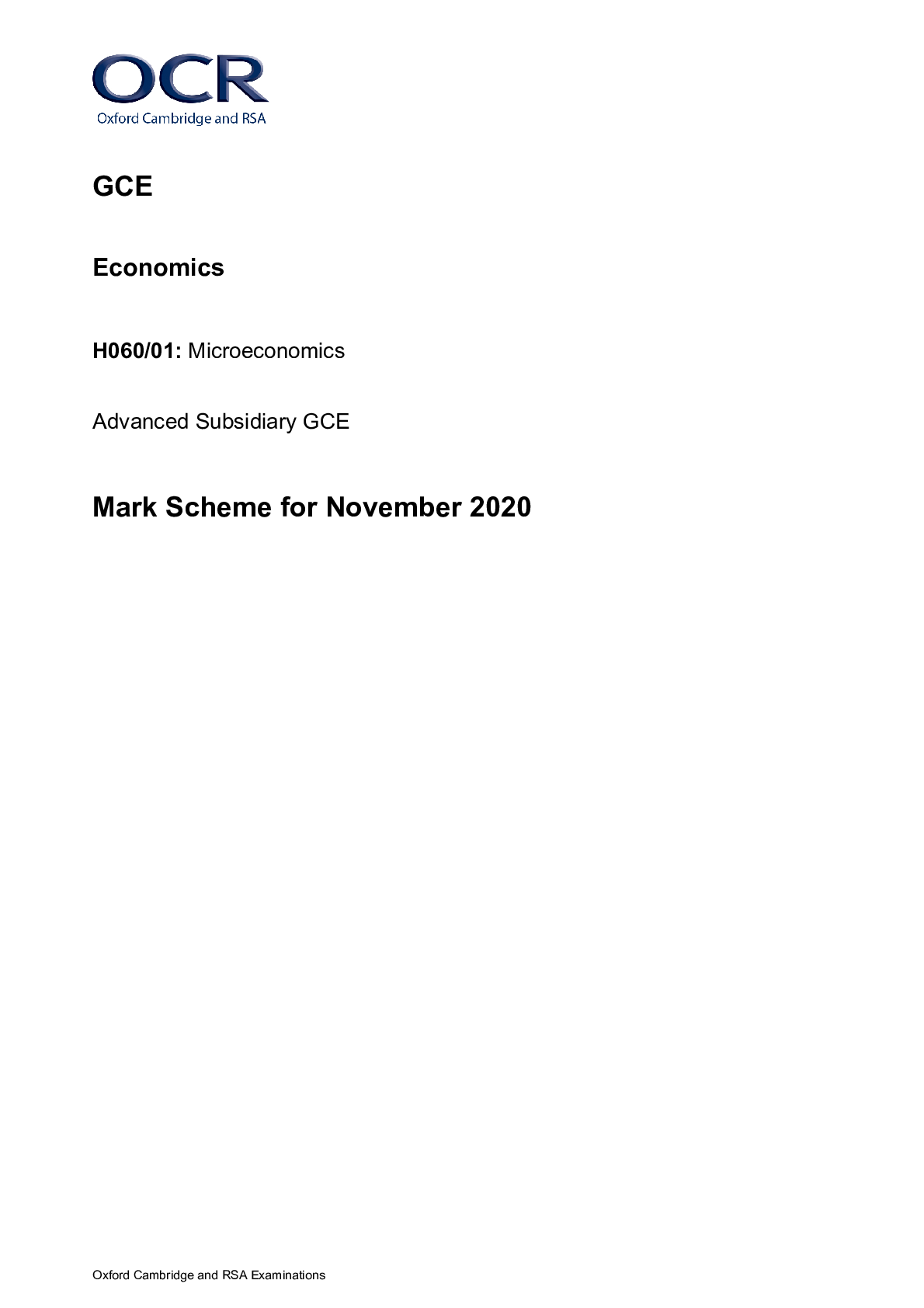
Reviews( 0 )
Document information
Connected school, study & course
About the document
Uploaded On
Oct 10, 2022
Number of pages
24
Written in
Additional information
This document has been written for:
Uploaded
Oct 10, 2022
Downloads
0
Views
123

